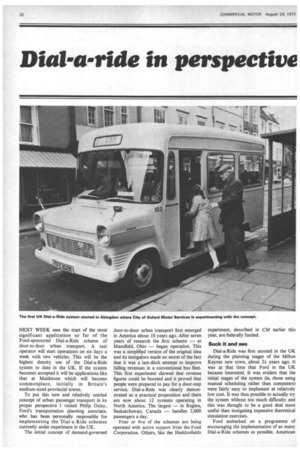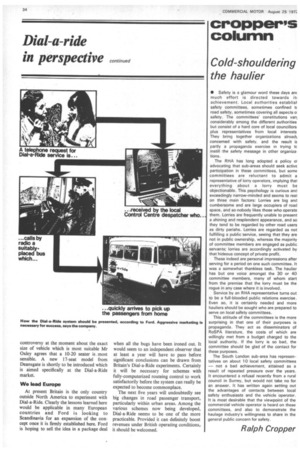Dial-a-ride in perspective
Page 34

Page 35

Page 36

If you've noticed an error in this article please click here to report it so we can fix it.
NEXT WEEK sees the start of the most significant application so far of the Ford-sponsored Dial-a-Ride scheme of door-to-door urban transport. A taxi operator will start operations on six days a week with two vehicles. This will be the highest density use of the Dial-a-Ride system to date in the UK. If the system becomes accepted it will be applications like that at Maidstone which will become commonplace, initially in Britain's medium-sized provincial towns.
To put this new and relatively untried concept of urban passenger transport in its proper perspective I visited Philip Oxley, Ford's transportation planning associate, who has been personally responsible for implementing the Dial-a-Ride schemes currently under experiment in the UK.
The initial concept of demand-governed door-to-door urban transport first emerged in America about 10 years ago. After seven years of research the first scheme — at Mansfield, Ohio — began operation. This was 'a simplified version of the original idea and its instigators made no secret of the fact that it was a last-ditch attempt to improve falling revenues in a conventional bus fleet. This first experiment showed that revenue figures could be boosted and it proved that people were prepared to pay for a door-step service. Dial-a-Ride was clearly demonstrated as a practical proposition and there are now about 12 systems operating in North America. The largest — in Regina, Saskatchewan, Canada — handles 2,000 passengers a day.
Four or five of the schemes are being operated with active support from the Ford Corporation. Others, like the Haddonfields experiment, described in CM earlier this year, are federally funded.
Suck it and see
Dial-a-Ride was first mooted in the UK during the planning stages of the Milton Keynes new town, about 2,L years ago. It was at that time that Ford in the UK became interested. It was evident that the initial stages of the system (ie, those using manual scheduling rather than computers) were fairly easy to implement at relatively low cost. It was thus possible to actually try the system without too much difficulty and this was thought to be a good deal more useful than instigating expensive theoretical simulation exercises.
Ford embarked on a programme of encouraging the implementation of as many. Dial-a-Ride schemes as possible. American
experience had shown that manual scheduling was efficient to a far higher level of service than originally supposed. This was useful in keeping costs down and encouraging small operators to play a part in restricted schemes. By the end of this year there should be six schemes operating in the UK and that number could double or even treble by the end of 1973. Inquiries for information are still being received regularly by Mr Oxley's department, from bus companies, taxi fleets and local authorities.
Here is the up-to-date situation on Dial-a-Ride developments — both existing and projected — in Britain: Abingdon: Although this was the first Dial-a-Ride service to begin operation, it is a very restricted project by City of Oxford Motor Services Ltd which at present operates only on parts of two days a week.
Maidstone: Starting next week, this service will be operated by a local taxi firm on six days a week. Two vehicles will operate services to the station and city Centre between 9am and 4pm and 6pm to late at night.
Harrogate: Following a licensing hearing only three weeks ago this two-vehicle service will operate what is basically a shoppers' service over fixed routes but with variable pick-up points in certain areas. If successful, nine more vehicles may enter service.
Bristol: A somewhat half-hearted attempt by British Rail to provide services from its new Parkway station looks doomed to failure following a decision by the Western Traffic Commissioners not to grant a full licence. So far Morris Marina cars have been used and the operation — not at present connected with Ford — is very close to a conventional taxi service.
Harlow: This will probably be the next Dial-a-Ride to begin and it could be the most advanced system yet. It is intended to operate six vehicles and it has been suggested that a computer is used for scheduling basically as a means of testing the idea. The service would be the first to utilize fully the concept of dynamic routeing and scheduling but the whole project is at present held up awaiting financial assistance from the Department of the Environment.
Eastbourne and Chelmsford: These are the last two towns where Dial-a-Ride is a serious possibility at present. The Chelmsford scheme would probably be operated by Eastern National, the local National Bus Company subsidiary.
Of course, it is far too early to draw any meaningful conclusions from the Diala-Ride experiments so far. However, the concept as a whole is clearly not being served well by schemes such as the one at Abingdon where the operation is so restricted that potential passengers never have a chance to become familiar with the service. The scheme at Bristol is far too like a normal taxi service to be a successful test of the Dial-a-Ride principle.
However, several valuable points have emerged so far. These include the evident keenness of most Traffic Commissioners to try something new in public transport. Also, a number of small operators have been encouraged to try the system; the Maidstone operation will only last if it is fully viable commercially. Mr Oxley's position is an interesting one. Contrary to popular opinion, Ford is not financially involved in the schemes. All the vehicles are leased to the operators — albeit at attractive rates — and free advice is given. Vehicles will be wholly owned by their operators when the schemes are better established. This means that though Ford's name is linked to the various schemes, it has little control over how they are operated. For instance, Ford is convinced that continuous, aggressive marketing is essential if the public are to use the services, but in practice this rarely happens. I asked Mr Oxley why Ford was involved at all and his answer was twofold: first because it is a means of promoting sales of Ford vehicles and, secondly, because the company decided that it was important to play a leading role in the development of the most practicable new idea in low-density passenger transport.
The company considers that restrictions on the use of private cars in urban areas will increase but should not automatically mean a restriction on personal mobility. Dial-a-Ride offers a service nearly as flexible and convenient as the private car, it is felt.
A wide scope for operators A number of developments are in store for Dial-a-Ride. Though the concept was never intended to handle high-density traffic flows and, as we have seen, initial development will tend to be in the smaller towns, there is no reason why it should not fill some of the gaps left by other forms of public transport. Once these gaps are identified — and many local authorities receive bags full of mail giving them advice on this score — then a Dial-a-Ride system could fill them.
While Ford is anxious that the scheme does not become indelibly identified with taxi work, and a true demand-governed system is more like bus than taxi work, one of its virtues is that it can be operated easily by various types of operator. In the fringe areas of the large cities a successful Dial-a-Ride operation serving rail stations during peak hours and shopping areas during off-peaks could be possible. This sort of service should be practicable in both affluent and less wealthy areas.
All the British Dial-a-Ride experiments, except the one at Bristol, are using Ford Transits with bodies by Strachans and Williams-Deansgate. Both these bodybuilders have studied the Dial-a-Ride concept in some detail. Though there is some small controversy at the moment about the exact size of vehicle which is most suitable Mr Oxley agrees that a 10-20 seater is , most sensible. A new 17-seat model from Deansgate is shortly to be introduced which is aimed specifically at the Dial-a-Ride market.
We lead Europe At present Britain is the only country outside North America to experiment with Dial-a-Ride. Clearly the lessons learned here would be applicable in many European countries and Ford is looking to Scandinavia for an expansion of the concept once it is firmly established here. Ford is hoping to sell the idea in a package deal when all the bugs have been ironed out. It would seem to an independent observer that at least a year will have to pass before significant conclusions can be drawn from Britain's Dial-a-Ride experiments. Certainly it will be necessary for schemes with fully-computerized routeing control to work satisfactorily before the system can really be expected to become commonplace.
The next five years will undoubtedly see big changes in road passenger transport, particularly within urban areas. Among the various schemes now being developed, Dial-a-Ride seems to be one of the more practicable. Provided it can definitely boost revenues under British operating conditions,. it should be welcomed.




















































































